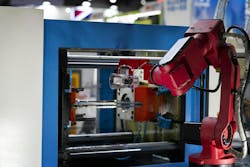Economic turmoil worries manufacturers: Wipfli report
By Karen Hanna
Amid volleys of new tariffs, manufacturers surveyed by Wipfli in the second quarter of this year reported feeling glum, after entering 2025 cautiously optimistic.
The accounting and advisory firm’s latest benchmarking report shows profitability is mostly flat. It was drawn from the responses of people at 285 locations across 249 companies, looking at performance trends, operational benchmarks and strategic priorities among plastics processors, metal formers, die casters, tool builders, contract machinists and other manufacturers.
Capacity utilization has fallen to 53 percent, a significant shortfall from the 63 percent that was previously forecasted. Echoing those results, two-thirds of respondents to a recent Plastics Machinery & Manufacturing poll said they had open capacity.
Quoting activity is up, but job hiring and capital investments seem to be stalled, as employers cope with uncertainty.
“Manufacturers are doing their best to hold on in a tough environment,” said Laurie Harbour, a Wipfli partner. “While some are hiring, it’s often out of necessity rather than growth. The industry must act swiftly to improve operations and navigate uncertainty.”
According to an executive summary of the report, “Top performing manufacturers dropped in overall profitability and operational efficiency in 2024. This performance is a continual decline from the boom profits of 2021.”
The report found manufacturers are most concerned about tariffs on raw materials, inflation, the risk of recession and rising cost of doing business.
“Lack of sales growth is a top concern for many manufacturers, and it relates directly to the higher cost of doing business. For many manufacturers, costs are rising but sales are not,” the executive summary states.
However, quote activity is on the rise, with hit rates across all manufacturing sectors averaging 11.2 percent, led by plastics processors at 12.2 percent. As Wipfli’s press release states, “This increase in quoting suggests that customers are exploring reshoring options and testing new supplier relationships — but not necessarily committing to new orders.”
Unlike recent years, when manufacturers struggled to attract enough workers, manufacturers surveyed by Wipfli largely reported holding steady when it comes to employment levels. Thirty-eight percent reported maintaining current staffing levels, while 37 percent reported hiring for growth or open positions.
That same sentiment seems to have held for capital investments as well, with manufacturers having invested in automation and digital technologies in 2024 despite high interest rates.
Harbour, who works with manufacturers to help them achieve greater efficiency and productivity, noted that manufacturers are still striving to make gains.
“Tariff uncertainty is weighing heavily on decision-making,” she said. “But we're also seeing manufacturers take control where they can — through cost management, efficiency and targeted investment.”
According to the report, efficiency among top performers averaged $139,800 per employee in 2024, only slightly below the 2023 peak of $143,593. Meanwhile, according to a Wipfli press release, “Debt-to-earnings ratios showed that 46 percent of manufacturers remain in a bankable position, 23 percent identify as somewhat bankable while 31 percent fall into the ‘questionably bankable’ category.”
Conducted annually since 2016, the Wipfli report is available to manufacturers who participate in at least one section of Wipfli’s manufacturing benchmarking survey. To learn more about the firm’s data offerings, visit wipfli.com/manufacturing.
About the Author
Karen Hanna
Senior Staff Reporter
Senior Staff Reporter Karen Hanna covers injection molding, molds and tooling, processors, workforce and other topics, and writes features including In Other Words and Problem Solved for Plastics Machinery & Manufacturing, Plastics Recycling and The Journal of Blow Molding. She has more than 15 years of experience in daily and magazine journalism.
